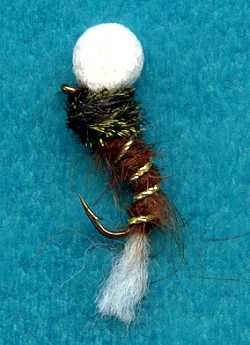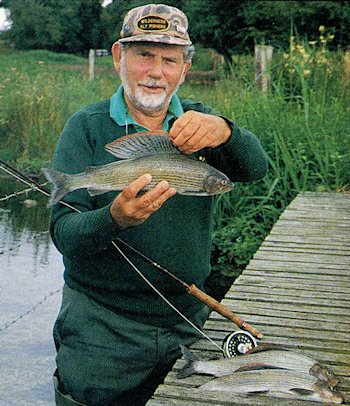Brown Suspender Midge Pupa Buzzer
John Goddard designed the Suspender midge pupa buzzer nymph. A lot of trout spend a good proportion of their time feeding exclusively on smuts or tiny insects. Smutting trout are instantly recognisable, lying very close to the surface and sucking in hatching flies.

SUSPENDER MIDGE EMERGING BUZZER FLY PATTERNS. Hook size 10 12 14 - $US each
The ring of the rise is sometimes only just visible, because the neb of the trout barely breaks the surface. The rise is sometimes very regular and rapid, sometimes exceeding ten times a minute. Smutting trout can be so infuriating as in most cases they ignore even very small dry flies. If you are lucky to get a hook up on a hook size 22 or 24 dry fly the odds of landing a trout in weedy waters are fairly remote. Many anglers still call these smuts as the "curse", "angler’s curse" or "black curse". They are not a new problem. In 1867 fly fishing author Francis Francis in his book called "A book on Angling" called small black gnats "Fisherman’s Curse" because of the problems catching trout feeding on these small items of fish food.

This is fly fisherman John Goddard designer of the Suspender Buzzer with three garyling destined for the cooking pot
John Goddard, the famous fly fisherman, writer and fly designer tried to come up with an answer to this problem. He had experimented with different patterns to try and solve this vexing of all dry-fly problems, but with little success. In 1985 whilst fishing the clear waters of the chalk stream fed River Test, in the south of England he decided to try his luck on a rather slow section of a carrier stream. Many of the trout in this part of the water system spent nearly all day feeding on smuts. John concluded that the basic problem was without doubt linked to the exceptional size of the natural reed smuts on which the trout were feeding, so the answer seemed to be in making an artificial fly that was small enough to deceive the trout but with a hook large enough to hold the fish once it had been hooked.
The answer seemed to lie in using a small hook with a wide gap. John used an up eyed hook made by Partridge ltd that had these qualities and tied on some black ostrich herl for about a third of the length of the hook shank from the eye to represent the small black gnat. The fly called the Goddard’s Smut had the correct silhouette but provided a hook that was large enough to hold onto trout. Another similar pattern is the Griffith’s Gnat dry fly. John thought he had cracked the problem. He started to catch fish but soon realised that the pattern was not consistently successful as hoped. .
John Goddard also had an interest in entomology and published books on identification of different types of mayflies and caddis. Over the years he had conducted research into what trout ate by examining their stomach content. He found that those feeding on the tiny smuts were also feeding on the bigger rising chironomids pupa just underneath the surface at the same time. On many occasions john found that a trout’s stomach was packed both with tiny white and black smuts as well as bigger brown and green chironomids.
It was like a light bulb going off in his head, a eureka moment. If you want to catch fish that appear to be feeding on the tiny flies on the surface present them with wet flies that imitate the other unseen insects that they are gorging themselves on at the same time.
John had designed a very productive still water pattern in the late 1970’s called the "suspender midge pupa", also known as the "suspender buzzer". He had previously not used it when river fishing. When he tried it for the first time on the River Test on surface smut feeding trout he was happily surprised at the results. On countless occasions John observed trout chasing his size 16 suspender midge pupa pattern even though there were hundreds of tiny flies hatching on the surface. This was true out of the box thinking that was the result of research and observation.
The moving chronomid pupa imitation probably appears quite natural to the trout. When the natural rises to the surface to hatch it initially hangs vertically in the surface film as it drifts along in the current. This is what the suspender buzzer nymph imitates when it is fished dead drift. When the natural pupa insect is ready to hatch from the pupal case, it nearly always adopts a horizontal posture and then swims along beneath the surface film looking for weak surface tension through which it can emerge. It is then that the retrieved suspender buzzer simulates the natural.
At dusk I am sure that many fly fishermen have experienced the frustration of trying to cast a dry fly to trout that they can barely see rising. I have found that trout tend to feed almost exclusively on small midges at this period, so they will often take a single suspender buzzer on point very confidently. The big advantage in using a suspender midge pupa pattern at this time in the evening is that if you cast it hard upon the surface, it makes a very distinctive dimple seen quite clearly when you are looking into the dying light. You then know exactly where your artificial has landed and the white ball of foam helps you track its movements. Takes are gentle so I have found it is essential to keep the line and leader straight. This is best accomplished by slowly raising the rod tip as your fly drifts towards you in the current.
Smutting or midge eating trout now should no longer pose you a problem. If they will not take your dry fly pattern then they most certainly will take a suspender nymph.
Fly Fishing books

